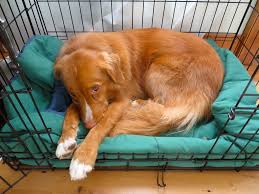Wondering how to crate train your dog or puppy? Or is it even necessary? Perhaps you might be worried that it is cruel to keep your dog in a crate? Maybe you don’t know about the benefits of crate training your dog? Trust me there are lots!
If you are curious about learning how to Crate training adult dogs/older dog or a puppy, regardless of how old they are, you will learn everything you need to in this article. We will answer all your questions (including how to crate training a rescue dog).
But first, let’s learn what crate training a dog is?
Before starting training your pooch for the crate, it is important to know what it really means.

Dogs are like family member and giving them their own personal space to live in is a good idea. Crate training is a process of teaching your puppy or dog that they have their own special happy place that is Crate, a place to chill and relax, so they are willing and look forward to spending some calm there.
A dog trained for crate would voluntarily want to go in their crate without any force and feel comfortable and calm locked inside. They show no sign of stress and cause no fuss. They fell safe and secure inside the crate and feel happy and often they go the crate on their own to have some happy time.
Benefits of Crate Training
There are many good reasons to crate train your dog or train a puppy. Crate training is beneficial for both you and your dog. Here is a list of some crate training benefits:-
- Helps in housetraining- A crate is a great way to housetrain a new puppy.
- Easy Transport- when traveling it becomes easier to transport a dog safely in the car.
- Noise Refuge- Crate becomes a safe place for the dog. It is a retreat at times when the dog gets anxious due to excessive party noise, thunderstorms and during other stressful events at home.
- Preventing injury- Crate help in preventing dogs from getting injured when you are away or leave the house for running errands.
- Keep your stuff safe- crate training helps in protecting floors, furniture and other things at home when you are not around.
- Post-surgery convalescence- your dog will feel happy, safe and there will be fewer chances of any complications after surgeries that require restrictions on running or moving around too much.
Is Dog Den Animal?

Put your mind at ease and clear all the confusion that you might have regarding this topic. While the dog is not a den animal technically, as they do not spend their lives in a den and have no denning instinct but when a dog is pregnant they seek out for a den-like safety to give birth and rear puppies. Some puppies tie back to their memories of being with mom and other mates in safe den-like space. Also when dogs are injured, ill and need their own place to relax to feel safe they seek out to a protected closed space.
You may worry that it’s mean to keep them in a jail-like space but the truth is the opposite. A dog when crate trained willingly goes inside to spend their “me” time. A crate is a protective and calming space for your dogs when they can relax.
How to crate training adult dog / how to crate training a rescue dog?
if your dog was never house trained then training for a crate will not be very easy. Crate training a puppy and a dog are different.
Depending on how old the dogs is, his past experiences and temperament issues (especially in case of rescue dog), the process of crate training can take weeks. It is important to be positive and patient and keep praising the dog at every successful step. Make small steps and avoid rushing too fast.
If you want to know how to Crate training an older dog, then follow the below-mentioned steps.
- The first step is to make sure the dog is all-out energy and doesn’t need to go to the bathroom. Go for a play ball, a long walk, etc.
- Puppies don’t have any particular habit while adult dogs are used to ever living in a crate. This is why older dogs take time to get used to a crate. Be patient and kind and try to create a positive association between the dog and the crate. You have to make it a happy place for your dog. Take small steps. Start by feeding meals near a crate.
- Make the crate a nice and comfy place. Put your old t-shirt, dog’s favorite toy a soft blanket and a chew toy if needed. Creating a comfortable environment in the crate will help him/her accept the dog crates a lot easier. Open the door so that he can enter the crate and go out of the crate as and when he pleases.
- When your dog gets used to being inside the crate with an open door, start to close the door for small periods and a small amount of time. Wait near the crate until the dog is inside, offer a treat and toy to distract the dog and close the door. Stay within your door’s sight, keep it closed for five minutes and slowly increase the time durations.
- Keep practicing and let the dog sit in the crate with the door closed, and increasing the time duration gradually until you can leave the house without getting your dog upset.

Tips to encourage voluntary crate training
Here are some tips to make crate training a voluntary practice for your dog or puppy.
- Praise a dog when crated
- Start with short durations and leave treats or toys inside
- Feed dog in the crate with open doors
- Crate train the dog for a recommended time until the dog can hold bowel and bladder
- Make the crate a happy place and never force a panicking and scared pup into the crate
- Make to supervise every crate session
- Keep soft blanket inside the crate to make it comfortable
Training schedule for Puppy crate
Young puppies don’t have much bladder and bowel control and crating them for longer periods of time
- Break the crate time with play or walk time and short activities. The crate should be a relaxing place for them, where they can rest, hang out and enjoy chew time.
- Puppies younger than 6 months should not be left in a crate for more than 3 consecutive hours, they require constant potty breaks.
The thumb rule is to keep crate the pup for time (in hours) = their age in months +1
So a 4-month puppy should be kept for 4+1=5 hours in the crate. But the only problem is that every puppy has a different bladder controlling time. Never exceed 5 hours of crating duration. Let your puppy out of the crate as much as possible, use it as a management tool not make the crate their lifestyle.

What to do if your puppy gets anxious and cries to get out?
If your puppy is in a stage where he starts creating fuzz in closed crate doors and cries out to get out, the worst thing you can do in this situation is to let the puppy out of the crate.
This will make them habitual of crying and whining to get out and you would not want this. We want them to teach them to stay calm, relaxed and enjoy the crate time. Reward them for staying calm in the crate.
Don’t let the pup out when they cry and scream loudly, instead give them a toy or treat inside the crate to distract them. If you will let the puppy out when crying it will become difficult to fix later in the future.
In the initial stages of crate training, when the pup is making a fuss, reassure the pooch until calm and release them only when they are quiet. Go back a few steps in the training.
In the later stages of crate training or when the pup is crated overnight, go to your puppy for 5 seconds only when they have become quiet. This will teach them the only way to see you or make you come to them is by being quiet.
When you try to approach them and they start crying ignore them to stay in the same room but keep yourself busy with some work and do not give them attention until they are quiet again.
What if you adopt a pre-crate-trained dog?
The benefit of adopting a crate trained puppy or dog is that the new pet parent can easily crate their new four-legged family member for safety and comfort, of both pup and humans. Crates will be seen as their own home in the new home and will be seen as a private, comfortable den for adopted dog and it helps to avoid the following:
- Dog greeting a guest rambunctiously

Image source - Running through the house rampant when the family goes out
- Chewing house items like sofa, Cushions.
















